The centennial celebration of The American Phytopathological Society (APS) has reminded us of the achievements of plant pathologists over the past century. Each discipline in plant pathology has contributed significantly to the advancements of our science. In 2007, a symposium was held at the APS meeting in San Diego to celebrate more than two and a half centuries of plant nematology since the discovery of plant-parasitic nematodes by Needham in 1743. This article has been produced and synthesized by the organizers and speakers from the symposium. We do not attempt to present another history of plant nematology, since the history has been reviewed extensively by Barker (2,3), Schmitt (84) (Fig. 1), Webster (103), Potter (72), Evans (25), Poinar (71), and recounted thoroughly by our predecessors Chitwood and Chitwood (15,16), Thorne (93), and Viglierchio (99). Rather, we will highlight the contributions of plant nematology to plant pathology by providing a few key examples that cover a wide range of studies in nematology.
| |
 |
|
 |
|
| |
Fig. 1. Ken R. Barker and Don P. Schmitt, along with other nematologists, published several books and articles on the history of nematology. |
|
The Beginning
The earliest allusion to a plant-parasitic nematode is found in William Shakespeare’s 1594 Love Labour's Lost, Act IV, Scene 3 as "Sowed cockle, reap'd no corn." This line most likely refers to infection of the plant-parasitic nematode Anguina tritici (93). However, it was not until 1743 that nematodes were identified as causal agents of plant disease. Needham solved the "riddle of cockle" when he crushed a diseased wheat grain and observed "Aquatic Animals…denominated Worms, Eels, or Serpents, which they very much resemble." While now recognized as the first documentation of anhydrobiosis, this observation was used by many scientists of the day to support "spontaneous generation" of organisms.
By the mid-1800s, scientists began to recognize more nematodes as causal agents. In addition to his seminal work with fungi, the Reverend Miles Berkely determined that the galls on cucumber roots were caused by root-knot nematodes, Meloidogyne spp. Schacht appropriately ascribed the cause of "beet-tired soil" to the sugar beet cyst nematode, Heterodera schachtii, in 1859. In the early 1900s, the father of American nematology, Nathan A. Cobb, began his nematological research. He described 1,000 nematode species while developing tools and apparatus that advanced the science. In 1907, Cobb joined the USDA and worked on pests of cotton. In a secondary assignment, he inspected the 1909 Japanese gift of 2,000 cherry trees to the United States. He found the trees severely infected with nematodes and other pests and had the trees destroyed. This situation motivated Cobb to develop procedures leading to the Plant Quarantine Act of 1912. Cobb is among the first advocates of exclusion as a management strategy for plant disease. Quarantine programs for nematodes have demonstrated the importance of early detection and sanitation measures for disease control. Cobb’s insight and perseverance led the United States Department of Agriculture to establish the Division of Nematology within the Bureau of Plant Industry in 1915. Cobb proceeded to train the first generation of nematologists in America. Cobb and his student G. Steiner proposed that nematodes could be the primary cause of a plant disease. At the same time, G. Thorne proposed that nematodes may be the cause of tobacco decline.
The Nematological Explosion
Awareness of nematode problems was heightened in 1941 when the golden cyst nematode was discovered on Long Island, NY. This nematode had devastated the European and South American potato crops and a federal quarantine, which still exists, was put into place. In 1950, B. G. Chitwood and M. B. Chitwood added greatly to nematode systematics with the publication of their work entitled An Introduction to Nematology, which served as a primary textbook until the publication of G. Thorne’s Principles of Nematology in 1961. In 1951, Christie and Perry demonstrated that the dorylaimoid nematode Trichodorus sp. was a plant parasite, proving that plant parasitism was occurring across orders of nematodes. Recognition of the importance of nematode causal agents of plant disease continued to increase when the tobacco cyst nematode, Globodera tabacum solanacearum, and the soybean cyst nematode, Heterodera glycines, were discovered in the United States in 1951 and 1954, respectively.
The science of nematology received a major catalyst with the discovery and use of fumigant nematicides. The discovery of 1, 3-dichloropropene (1, 3-D) , and ethylene dibromide (EDB) in the 1940s not only provided a way to control nematodes, but also aided scientists in demonstrating the impact of nematodes in the field.
By the late 1950s, funding from government and commercial sources for nematology programs sparked phenomenal growth in the science. Several nematology courses and symposia were held in Europe. In order to address nematode problems in the United States, nematologists gathered in Nematology Workshops sponsored by the Shell Oil Company. For years, American nematologists’ primary venues for information exchange and paper presentations were at the annual meetings of the APS and the American Institute of Biological Sciences (AIBS) symposia. By 1952, a symposium session was dedicated for nematology at the APS annual meeting at Cornell University. Since then, nematology sessions have become a regular component at our APS meetings.
In the hundred years since the founding of APS, plant pathologists have proposed theories and explained observations about how plant diseases progress. Nematological pathosystems have been used to validate many of our pathological theories, insights and observations.
Plant Pathogens Interact to Cause Disease
Many disease complexes involve plant-parasitic nematodes as pathogens. Nematodes may serve as vectors, or may cause wounding that allows infection or predispose plants to other pathogens. As early as 1892, Atkinson had already noticed that nematodes attacking cotton plants predispose the plants to Fusarium wilt. Pitcher (70) proposed several mechanisms of interaction between nematodes and other soil-borne diseases. These mechanisms are further summarized by Manzanilla-Lopez et al. (54) indicating that nematodes (i) cause wounding that provides an entry point for pathogens that might have already been present in the rhizosphere; (ii) act as vectors of plant pathogens such as nematode-transmitted plant viruses; (iii) act as "providers of necrotic infection courts" by leaching out substrate from host plants that might serve as a "food base" for weaker pathogens unable to infect plant cells directly; (iv) "deter" plant disease by grazing on fungal pathogens as in the case of Aphelenchus avenae (54); and (v) break disease resistance, impairing the host defense reactions by which healthy plants would otherwise repel pathogens (54).
Today, several disease complexes that generate close collaboration between nematologists, mycologists and virologists include potato early-dying disease, black shank-root knot complex, soybean sudden death syndrome, peach tree short-life, and annual ryegrass toxicity, as well as interactions with nematodes and numerous plant viruses.
Potato early-dying. A synergistic interaction of Pratylenchus penetrans and Verticillium dahliae has been demonstrated to reduce yields and tuber quality of potato (53,55) (Fig. 2), resulting in potato early-dying disease. Wounded roots may stimulate the germination of the dormant microsclerotia of the fungus due to increased root exudation or may facilitate access for the fungus to the vascular tissues. Some have also suggested that the nematode suppresses the production of phytoalexins (73). Later, Saeed et al. (79) demonstrated that there was a strong reduction of photosynthesis rate following joint infection by both pathogens as compared to infection by either of these pathogens alone.
| |
 |
|
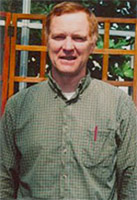 |
|
| |
Fig. 2. An MacGuidwin and Douglas Rouse work together on the potato early dying disease complex. |
|
Black shank-root knot complex. Black shank is a widespread and destructive disease in most of the flue-cured tobacco production areas of the United States. It is caused by Phytophthora parasitica var. nicotiana which lives in the soil. Black shank and root-knot nematodes may coexist in the same field and cause the black shank-root-knot complex on tobacco. Effects of nematode damage on severity of the black shank have been demonstrated by Johnson, Csinos, and their colleagues (39). In fields infested with both the black shank oomycete and root-knot nematodes, the effectiveness of black shank resistant cultivars and fungicides is reduced if the nematodes are not controlled. Control of root-knot nematodes helps to ensure the effectiveness of fungi resistant cultivars and fungicides.
Soybean sudden death syndrome. Sudden death syndrome (SDS) of soybean is caused by Fusarium solani. However, the soybean cyst nematode, Heterodera glycines, is often associated with SDS. Soybean cyst nematode may enhance symptom expression of SDS or cause symptoms to appear earlier than those induced by F. solani alone (56,78) (Fig. 3). While the role of H. glycines in SDS under field conditions has not been resolved, soybean cultivars resistant to H. glycines have been less affected by SDS compared to susceptible cultivars (77). Interestingly, numbers of soybean cyst nematodes were lower in plots infested with F. solani and H. glycines than with the nematode alone. In fact, F. solani was observed to infect cysts and eggs of soybean cyst nematode (56).
| |
 |
|
Fig. 3. Kathy Lawrence worked with soybean sudden death syndrome. |
|
Peach tree short life. The migratory ectoparasitic ring nematode Criconemoides xenoplax, the root-knot nematode Meloidogyne spp. and possibly other nematodes are major factors in Peach Tree Short Life (PTSL), a syndrome that results in premature mortality of peach trees in the southeastern United States. (67) (Fig. 4). PTSL is characterized by the sudden spring time collapse and death of young trees, typically 3 to 7 years of age. The final killing factor for PTSL is believed to be cold injury caused by Pseudomonas syringae. Plant pathologists and nematologists are working together to search for microbial biocontrol agents (e.g., fluorescent pseudomonads) against C. xenoplax (48).
| |
Fig. 4. Andrew Nyczepir demonstrated that ring nematodes and possibly other nematodes are major factors in Peach Tree Short Life syndrome. |
|
 |
|
Annual ryegrass toxicity. Annual ryegrass toxicity (ARGT) was first reported in western Australia in the late 1960s (74). Annual ryegrass (Lolium rigidum) infected by the actinomycete Rathayibacter toxicus (previously known as Clavibacter toxicus) which is carried to the ryegrass inflorescence by the nematode Anguina funesta. The actinomycete produces toxins that affect grazing animals. Interestingly, there has been a marked decline in the incidence of ARGT in some areas. Riley (74) reported that the decline of ARGT is due to the fungus Dilophospora alopecuri, which also relied on the nematode to carry it to the inflorescence of ryegrass. The fungus limits the actinomycete infection to the gall and surrounding tissues fed on by A. funesta. However, the fungal infection can also develop to the entire seedhead and cause the seedhead to be twisted. The study of this disease and the symbiotic relationship between the nematode and the fungus is a good example of the close connection between plant pathology and nematology.
Nematodes and viruses. In the first quarter of the 20th century, several plant diseases were attributed to soil-borne viruses with speculation that nematodes might be vectors. It was not until 1958 that specific nematodes were shown to transmit specific plant viruses. The first reported nematode-transmitted virus was grapevine fan leaf virus (GFLV), a nepovirus, which is transmitted by Xiphinema index in vineyards in California (33). Today, of 4,000 species of plant-parasitic nematodes described, only 30 species in two nematode families are known to be virus vectors (10). The Longidoridae (Longidorus, Paralongidorus, and Xiphinema) transmit nepoviruses, and the Trichodoridae (Paratrichodorus and Trichodorus) transmit tobraviruses. These nematodes and their associated viruses occur worldwide on fruit, vegetable, and ornamental crops and are of substantial economic importance (104). Examples of nepoviruses include tomato ringspot (ToRSV), cherry raspberry leaf (CRLV), peach rosette mosaic (PRMV), grapevine yellow vein, arabis mosaic (ArMV), strawberry latent ringspot (SLRSV), and GFLV. Examples of tobravirus include tobacco rattle (TRV), pea early-browning (PEBV), and pepper ringspot (PRV). ToRSV is the most economically important and widespread nematode-transmitted virus in North America. ToRSV has a wide host range (35 plant families) and is considered a quarantine-significant pathogen in Europe and Africa. TRV, commonly known as "spraing" in Europe and "corky ring spot" in North America on potato, is the most widespread and economically important member of the Tobravirus genus (10). This virus has the widest host range of any plant virus and infects many weed species without producing symptoms (10).
Modeling and Precision Agriculture
From the first, nematologists were forced to take a quantitative approach to diseases caused by nematodes. Nematologists were early advocates of the concepts of critical point models for estimating crop loss. Early on, Seinhorst (85) recognized that food sources become limited as nematode populations grow and thus suggested the use of logistic growth models to describe density-dependent growth of nematode populations. Seinhorst (86) and Jones et al. (40) pioneered in modeling nematode population dynamics and were developing crop-response models to predict crop losses caused by nematodes. Although it is convenient to obtain an estimation of final population densities (Pf) from initial population densities (Pi), in reality this often results in weak predictions (58). Ferris (26) and McSorley and Phillips (57) later improved the models by including stochastic or probabilistic statements. Perhaps one of the most successful uses of nematode population modeling was the development of the Integrated Pest Management (IPM) program for nematode management in the potato cyst nematodes (PCN) in Europe. Between 1984 and 1998, soil fumigation for control of PCN in the Netherlands declined by 85 percent as a result of these IPM programs (5).
While it is generally accepted that initial nematode population densities prior to crop planting provide a good estimation of crop loses due to plant-parasitic nematodes, it is often impractical to take enough nematode samples to predict crop loss in an intensively managed field. Using the knowledge of the relationship of nematodes with soil texture, nematologists currently are employing mobile soil electrical conductivity meters and other precision agricultural techniques, including "global positioning systems" and "geographical information systems" to determine where and when to apply nematicides in fields (61).
Control of Soil-borne Diseases
Nematology has contributed greatly to our ability to control soil-borne diseases. Since most plant-parasitic nematodes are soil borne, those working with nematode pathogens have had to contend with the complex physical, chemical, and biological nature of soils. The need for nematicidal agents has been and continues to be great. Consequently, many products and approaches have been offered to producers. Lessons and experiences from the control of nematodes have been applied to many other soil-borne pathogens.
Biological control. Early scientists turned to biological control for soil-borne nematodes because nematode antagonists were common in occurrence and performed well in Petri dish experiments. Nematode antagonists have been observed among a wide range of organisms including fungi, bacteria, viruses, rickettseae, plants, protozoans, turbellarians, tardigrades, enchytraeids, mites, insects and even other nematodes. Among these, fungal and bacterial antagonists have been the most extensively studied.
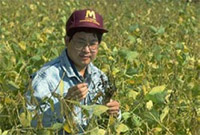
Fig. 5. Senyu Chen works with nematode-antagonistic fungi against soybean cyst nematodes. |
|
Nematologists and mycologists have contributed mutually to studies of nematode-antagonistic fungi. Pioneers in the study of the fungal antagonists were mycologists C. Drechsler, R. P. Dolfuss, and G. L. Barron. These pioneers discovered, described, and studied a wide variety of fungi including those with adhesive hyphal nets or knobs and highly specialized constricting rings or traps (4). Fundamental research of organisms preying on nematodes in soil and techniques to assay soil for biological control were developed in the first quarter of the 20th century. Linford (52) used predacious fungi to control plant-parasitic nematodes, thus stimulating interest in nematode-predacious fungi. A thorough review on biological control of nematodes by fungal antagonists has been presented by Tribe (95), Morgan-Jones and Rodriguez-Kabana (62), Stirling (92), Sikora (88), Kerry (44), Kerry and Jaffee (45), and most recently by Chen and Dickson (18) (Fig. 5). To date, only a few biocontrol agents have been developed commercially, including Paecilomyces lilacinus and Myrothecium verrucaria (DiTera, Valent BioSciences Corp.). While work is being done by nematologists, mycologists, and bacteriologists utilizing biocontrol agents against multiple soil-borne pathogens (76), more effort should be put into these collaborations (59).
Suppressive soil. In parallel to the discovery of wheat take-all decline in the 1980s (1,19), nematologists in Europe discovered naturally suppressive soil against the cereal cyst nematode (Heterodera avenae) in 1974 (43). It is now known that such soils are a widespread phenomenon throughout northern Europe (46) (Fig. 6). Gair et al. (28), Kerry and Crump (47) initiated a new concept, deviating from the common dogma of practicing crop rotation for nematode management. Instead, they suggested that nematode suppressive soils are often associated with monoculture of a susceptible host. Kerry et al. (47) demonstrated that the main nematode-suppressing agents in these soils were Pochonia chlamydosporium and Nematophthora gynophila. After 8 years of monoculture of nematode-susceptible wheat cultivars, population densities of cereal cyst nematodes often declined to non-detectable levels (46).
| |
 |
|
Fig. 6. Brian Kerry and his colleagues discovered the natural suppressive agents against cereal cyst nematodes. |
|
Pasteuria. Nematologists also work closely with bacteriologists especially when Pasteuria spp. were first found to be obligate parasites of plant-parasitic nematodes, and shown to have great potential as economically and environmentally friendly biological control agents. Field observations (7,22,60) (Fig. 7) and glasshouse and microplot experiments (14,17,20,68) have demonstrated that these organisms can provide effective control of plant-parasitic nematodes. There are four nominal species of Pasteuria that have been shown to attack plant-parasitic nematodes. Pasteuria penetrans has been described from root-knot nematodes (Meloidogyne spp.) (82,91), Pasteuria thornei has been reported from root-lesion nematodes (Pratylenchus spp.) (91) and Pasteuria nishizawae was found parasitizing cyst nematodes of the genera Heterodera and Globodera (83). More recently, a new species, ‘Candidatus Pasteuria usgae’ sp. nov., was found to parasitize sting nematodes on turfgrass, Beloinolaimus longicaudatus (30) (Fig. 8). Progress is being made towards developing a mass production of Pasteuria spp. in vitro (34).
| |
 |
|
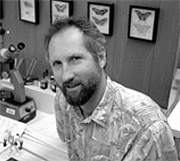 |
|
| |
Fig. 7. Don Dickson and colleagues work on introducing Pasteuria penetrans in fields and microplots to suppress root-knot nematodes on peanut. |
|
Fig. 8. Robin Giblin-Davis discovered a new species of Pasteuria, Candidatus pasteuria usgae’ sp. nov., parasitizing sting nematodes. |
|
Chemical control. The first attempts at nematode control, as with control of other recognized soil-borne diseases, involved compounds like sulfur and lime. The first soil disinfectant was carbon disulfide (CD). By 1933, CD was improved as liquid or less incendiary emulsion formulations, controlling 90% of nematodes in the field (31). About the same time, chloropicrin was evaluated as a soil disinfectant in the early 1920s (75), and methyl bromide was found to be an effective biocide in 1932. In 1943, W. Carter discovered D-D, the first 1,3-dichloropropene-containing product. It controlled mealybug wilt, pythiaceous organisms, and nematodes in pineapple (13). D-D represented the first packaged treatment that was user-friendly and almost guaranteed reduced nematode populations while improving plant performance. By the 1950s and 1960s, methyl bromide and 1,3-D dominated the fumigant nematicide market while the organophosphate and carbamate chemical classes dominated the nonfumigant market. A repertoire of products had become available for soil-borne pest and disease control. Vineyards, orchards and vegetable crops could be replanted with reduced nematode infestations, and the age-old term "soil sickness" soon went out of vogue.
| |

Fig. 9. Michael McKenry works with methyl bromide alternatives for nematode control on perennial crops. |
As more products became available, application techniques were developed that enhanced efficacy, reduced applicator exposure, and increased environmental safety. After World War II, tractors were produced that were capable of pulling shanks at depths of 1 m, allowing much deeper placement of fumigants. By the 1970s, A. Overman in Florida, W. Apt in Hawaii, and J. Radewald in California were evaluating applications of non-fuming nematicides, such as Nemacur, applied via drip irrigation (38). M. McKenry (Fig. 9) demonstrated that chemical application rates could be reduced by timing the nematicide to root phenology rather than to peak nematode populations. This nematicide application technology enhanced the widespread adoption of drip irrigation and significantly reduced pesticide application rates.
The health and environmental concerns in the late 1960s and early 1970s began to reduce the availability of pesticides for soil-borne disease control. The post-plant nematicide, 1, 2-dibromo-3-chloropropane (DBCP) was linked to male infertility in humans, and later was discovered in groundwater and use was suspended in California (32). DBCP had become the first pesticide to achieve notoriety as a groundwater contaminant. Traces of 1, 2-dibromoethane (EDB), an inexpensive chemical used for preplant soil fumigation, various other agriculture uses, and as a gasoline additive, were also found in groundwater. In early 1984, news pages across the nation headlined the finding of EDB in association with grain products, and it was quickly removed from use in the United States. Methyl bromide was found to contribute to ozone depletion, and its use was limited by the 1992 Montreal Protocol as implemented in the Clean Air Act, except for certain exemptions. In April 1990, air concentrations of 1, 3-D were detected in public buildings adjacent to land being fumigated for sweet potato production near Atwater, CA. New procedures and application equipment with caveats concerning soil moisture, application rates, and limitations were developed to maintain the registration of 1,3-D. The control of soil borne pathogens, once again, became a challenge.
Non-fumigant nematicides also have faced health and safety concerns. Aldicarb was incriminated in human poisonings following off-label application to watermelon, and was also detected in shallow ground water (42). Carbofuran was responsible for killing birds that drank from puddles associated with drip irrigation, but it was carbofuran’s detection in California and Wisconsin groundwater that sealed its fate. Also, the registration of phenamiphos was voluntarily suspended in 2007 after calls for additional expensive groundwater studies. This has prompted a new era of nematicide development towards biological-based products such as DiTera, which are more costly to apply and less effective than synthetic nematicides.
Host Plant Resistance
Nematologists have been early advocates for the use of host-plant resistance for disease control. Host resistance to root-knot nematode was first recognized in 1889 by Neal who suggested using selected orange-tree cultivars to control root-knot nematodes (12). In 1897, A. Zimmerman recommended grafting the more desirable Coffee arabica onto root-knot resistant rootstock of C. liberica (12). Additional resistance to root-knot nematodes was identified in a variety of crops in the early 1900s (90) (Fig. 10). Resistance to cyst nematodes was identified in sugar beets at the same time (105). Trudgill (96) clearly defined the differences between tolerance (host response to nematodes) and resistance (nematode reproduction on the host), and pointed out the importance of separating these two properties during nematode resistance screening programs. Nematology led plant pathology in transgenic resistance, incorporating root-knot nematode resistance, the Mi-1 gene, from the wild Lycopersicon peruvianum into the cultivated L. esculentum via embryo rescue (89). Nematode pathosystems have proven the universality of Flor’s gene-for-gene model. For example, the potato resistance gene Gro1-4 to Globodera rostochiensis and gene Gpa2 to G. palida, follow Flor’s model explicitly.
| |
 |
|
 |
|
| |
Fig. 10. James Starr and Terry Niblack contribute significantly to the study of nematode host-plant resistance and population dynamics. |
|
Nematode Parasitism Genes
The ability of nematodes to live on plant hosts involves multiple parasitism genes. The most pronounced morphological adaptations of nematodes for plant parasitism include a hollow, protrusible stylet (feeding spear) connected to three enlarged esophageal gland cells that express products that are secreted into plant tissues through the stylet. In recent years, a great deal of research has been conducted on the molecular biology of parasitism genes of plant-parasitic nematodes. A major contribution to the understanding of cyst nematode parasitism occurred when cellulose-degrading enzymes (ß-1,4-endoglucanases) from H. glycines and Globodera rostochiensis, the golden potato cyst nematode, were identified. The discovery that these genes have their greatest similarity to microbial genes stimulated the first speculation in plant pathology that genes for plant parasitism by nematodes may have been acquired by horizontal gene transfer (21) (Fig. 11). Other plant cell-wall-degrading enzymes discovered in plant-parasitic nematodes include pectate lyases, cellulose-binding proteins, and expansins (65). Comparison of the structure of parasitism genes encoding stylet secretions that induce feeding cell formation among species and within species will provide the knowledge that should lead to establishing a genetic basis for host range specificity among nematode species or races (36).
| |
 |
|
 |
|
| |
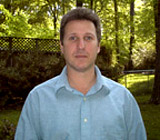 |
|
| |
Fig. 11. Dick Hussey, Thomas Baum, and Eric Davis work together in studying nematode parasitism genes. |
|
In addition, scientists over the years have been trying to understand how root-knot and cyst nematodes caused their host plants to form giant cells or syncytia cells. Nematode chorismate mutase (CM) was discovered in the root-knot nematode, Meloidogyne javanica (49), G. pallida (41), and H. glycines (6,29). The nematode CM has been shown to be secreted into the plant tissue by root-knot nematodes as feeding cells are being formed (24), but exactly how these enzymes might alter plant metabolism to form syncytia cells needs further study.
Variability Among Pathogen Populations
Similar to studies on most other pathogens, nematologists have attempted to define population variation by identifying "races," "pathotypes," and "biotypes" (87). Differences in host range were first noted among populations of Ditylenchus dipsaci in the 1800s. Sasser (81) differentiated populations of root-knot nematodes based upon host status. Twenty years later, variation of responses to resistance genes was noted in root-knot nematodes (63). One of the biggest challenges in describing population variation is with the soybean cyst nematode, Heterodera glycines. Originally, Riggs and Schmitt classified soybean nematode races based on four differential soybean hosts. This race scheme was subject to criticism because scoring was never absolute (64) (Fig. 10). A new classification scheme, HG Types (HG stand for Heterodera glycines), was proposed in 2002 (65) that involves seven sources of resistance including those used in developing resistant germplasm lines and cultivars in the United States. This scheme is open-ended, meaning additional soybean lines can be added, and is easily adaptable to different geographic areas (66).
Nematodes as Soil Health Indicators
Although traditional plant pathology is a study of plant diseases, a proportion of plant pathologists are very interested in using microbes as indicators for soil health and suppressiveness against pathogens. Initially, Ingham et al. (37) demonstrated that free-living nematodes in the soil have strong interactions with soil fungi and bacteria and play important roles in soil food-web processes such as soil nutrient cycling. Yeates (107) synthesized a feeding habit profile for an extensive list of soil nematodes, categorizing nematodes into algivores, bacterivores, fungivores, herbivores, omnivores, and carnivores. Although the feeding habits of some soil nematodes are still debated, Yeates’ list served as the foundation of nematode community analysis. Bongers and Bongers (8) integrated the knowledge of nematode feeding behavior and life strategies (colonizer vs. persister) and proposed the concept of nematode guild, which was later used to develop several nematode community indices. These indices include the maturity index, structure index (SI), enrichment index (EI), channel index (CI), and basal index (BI) (27), and are powerful tools used to describe soil food-web conditions. Such analyses provide slightly different information than analyses based on biomass, diversity, and plant-parasitic species, and take into consideration both descriptive and quantitative information on soil ecosystems. Continuous efforts are being made toward studying the relationship between nematode community indices and soil-borne disease epidemics (Fig. 12).
| |
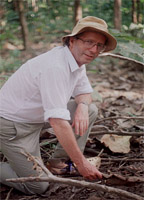 |
|
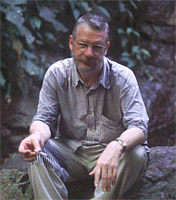 |
|
| |
 |
|
 |
|
| |
Fig. 12. Gregory Yeates, Tom Bongers, Howard Ferris, and Deborah Neher are nematode ecologists that contribute significantly to the study of nematode communities. |
|
Expanding the Boundary of Plant Pathology
Nematology is not limited to the study of plant-parasitic nematodes, but includes studies of free-living nematodes, entomopathogenic nematodes, and animal-parasitic nematodes, thus expanding the scope of plant pathology to ecology, entomology, zoology, and parasitology. Moreover, as nematodes are relatively small animals with rapid life cycles, scientists have found nematodes to be superb model organisms for genetic studies.
Contribution of nematology to cell biology and genetics. Nematologists as early as the late 1800s contributed significantly to other scientific fields. Butschli (11) first observed the formation of polar bodies by nuclear subdivision in a nematode. Van Beneden (97) was studying Ascaris megalocephala when he discovered the separation of halves of each of the chromosomes from the two parents and the mechanism of Mendelian heredity. Boveri (9) showed evidence for continuity of the germplasm and for the soma being regarded as a by-product without influence upon heredity. More recently, the completion of the C. elegans Genomic Project and the Human Genome Project is the beginning of a new era of opportunity as the ability to understand and relate the precise function and mode of operation of specific genes in the life of the nematode and of its host becomes possible. Webster (103) proposed that through the recognition of daf genes in C. elegans, which are highly conserved across phyla, scientists are enabled to better understand complexities of human aging processes and programmed cell death.
Environmental bio-indicators. In the study of free-living nematodes, beside the development of nematode community analysis, there are various unique studies that use nematodes as "environmental canaries" to measure nematode response to pollution in the air (80), oceans (94), and soil (50,97,98,100,101). Rankings among the lethal concentration (LC50) values for seven metals in bacterial-feeding nematodes were well correlated with the rankings of lethal dosage (LD50) values from mammalian systems, and the response level of C. elegans was similar to that of rats’ (23). Lau et al. (50) suggested introducing a bacterial-feeding nematode, Cruznema tripartitum, into soils being tested for toxicity. The survival and respiration rates of the nematodes provided a useful bioassay of the presence and concentration level of toxins such as trichloroethylene, toluene, and metam-sodium.
Human health. Recently there has been an exploitation of some bioactivities of the secondary metabolites from the bacteria symbionts Xenorhabdus spp. and Photorhabdus spp., which are mutualistic with entomopathogenic nematodes. Since the early 1980s (69), interest has grown in the antimicrobial properties of these substances, and a large number of antibiotic and antimycotic substances have been identified (106). These compounds or their derivatives have stimulated research into their potential use as naturally derived pharmaceutical drugs and agroforestry pesticides (17). Many of these secondary metabolites have chemical structures that are atypical for conventional antibiotics (51). Discovery of their nematicidal (35) and antineoplastic (102) effects has greatly expanded the study of nematology (103).
Concluding Remarks
The authors recognize that many nematological studies have contributed to plant pathology, such as that in the quantification of abiotic factors on diseases, pathogen responses to signals in the rhizosphere, the identification of antagonistic plants and the role of plant growth promoting rhizobacteria in biological control of nematodes. This article is not a comprehensive history of nematological contributions to plant pathology and, instead, focuses on selected contributions. There are many other contributions that benefited phytopathology in other parts of the world. Although the study of plant nematology is young, this short review indicates that this unique field of biology has evolved tremendously over the last 300 years and has contributed significantly to the study of plant disease. We conclude with Wilson’s (106) thought-provoking summation about the current state and future of plant nematology:
Nematodes are always working havoc, taking their toll on crops, sometimes causing complete destruction. We blind ourselves by accepting them as a matter of course. The problem is here; we live with it; but there is no solution. There must be a general awakening all along the line to the magnitude of this situation.
The contribution of plant nematology to plant pathology is not limited to the study of interactions between nematodes and other plant pathogens. With the rising concern about environmental health, and the banning of more nematicides, the magnitude of nematode damage should no longer be ignored. There is a trend that many departments of nematology in universities throughout the states are merging with other disciplines such as entomology, zoology, ecology, and others. As shown in this review, nematology continues to strive in its diverse contribution to plant pathology, and is expanding the boundaries of plant pathology to cell biology and genetic, human and environmental health studies, and even in space science (102). Nonetheless, more collaboration between nematologists with other scientists in plant pathology to develop sustainable agricultural system should be highly encouraged.
Additional Resources
Nematode Makes Scientific History
APSnet press release
American Phytopathological Society, St. Paul, MN
Nematology History
J. Cardenas and T. Nagler
Department of Nematology, UC Davis
Nathan A. Cobb, The Father of Nematology in the United States
R. N. Huettel and A. M. Golden
Annual Review of Phytopathology & USDA-ARS
Nematology at Cornell: A History
W. F. Mai
Cornell Univ., Dept. of Plant Pathology and Plant-Microbe Biology
History of Nematology with Photographs of Nematologists
K. B. Nguyen
University of Florida, Entomology & Nematology Department
History of Nematology in Florida
V. G. Perry, G. C. Smart Jr., and K. B. Nguyen
University of Florida, Entomology & Nematology Department
The History of Plant and Soil Nematology in Australia and New Zealand, with Particular Reference to the Contributions of Six Pioneering Nematologists
G. R. Stirling, G. W. Yeates, K. Davies, and M. Hodda
Australasian Plant Pathology, CSIRO Publishing
An Anecdotal History of Nematology
J. M. Webster, J. M. Eriksson, and K. B. McNamara
PENSOFT Publishers, Sofia, Bulgaria
Literature Cited
1. Asher, M. J. C., and Shipton, P. J. 1981. Biology and Control of Take-all. Academic Press, London, UK.
2. Barker, K. R. 1998. Introduction and synopsis of advancements in nematology. Pages 1-20 in: Plant and Nematode Interactions. K. R. Barker, G. A. Pederson, and G. L. Windham, eds. ASA, CSSA, and SSSA, Madison, WI.
3. Barker, K. R. 2004. A century of plant nematology. Pages 1-51 in: Nematology Advances and Perspectives. Vol. 1. Nematode Morphology, Physiology and Ecology. Z. X. Chen, S. Y. Chen, and D. W. Dickson, eds. CABI Publishing, Beijing, China.
4. Barron, G. L.1977. The Nematode-destroying Fungi. Lancaster Press, Lancaster, PA.
5. Been, T. H., and Schomaker, C. H. 1998. Quantitative studies on the management of potato cyst nematodes (Globodera spp.) in the Netherlands, Wageningen. DLO-Res. Inst. for Plant Prot. (IPO-DLO), The Netherlands.
6. Bekal, S., Niblack, T. L., and Lambert, K. N. 2003. A chorismate mutase from the soybean cyst nematode Heterodera glycines shows polymorphisms that correlate with virulence. Mol. Plant-Microbe Interact. 16:439-336.
7. Bird, A. F., and Brisbane, P. G. 1988. The influence of Pasteuria penetrans in field soils on the reproduction of root-knot nematodes. Rev. de Nematologie 11:75-81.
8. Bongers, T., and Bongers, M. 1998. Functional diversity of nematodes. Appl. Soil Ecol. 10:239-251.
9. Boveri, T. 1893. Ueber die Entstehung des Gegensatzes zwischen den Geschlectszellen und den somatischen Zellen bei Ascaris megalocephala, nebst Bemerkungen zur Entwicklungsgeschichte der Nematoden. Sitzungsb. Gesellsch. Morph. u. Physiol. in Munchen.
10. Brown, D. J. F., Zheng, J., and Zhou, X. 2004. Virus vectors. Pages 717-770 in: Nematology Advances and Perspectives. Vol. 2. Nematode Management and Utilization. Z. X. Chen, S. Y., Chen, and Dickson, D. W. eds. CABI Publishing, Beijing, China.
11. Butschli, O. 1875. Vorlaufige Mittheilung uber Untersuchungen betreffend die ersten Entwickelungsvorgange im befruchehen Ei von Nematoden und Schnecken. Ztschr. Wiss. Zool. v. 25:201-213.
12. Campbell, C. L., Peterson, P. D., and Griffith, C. S. 1999. The Formative Years in Plant Pathology in the United States. American Phytopathological Society, St. Paul, MN.
13. Carter, W. 1943. Soil fumigant comprising 1, 3-dichloropropene and 1, 2- dichloropropane. US Patent # 2,502,244.
14. Channer, A. G., and Gowen, S. R. 1988. Preliminary studies on the potential of Pasteuria penetrans to control Meloidogyne species. Pages 1209-1214 in: Proceedings of the Brighton Crop Protection Conference, Pests and Diseases. Brighton Centre and Brighton Metropole, Brighton, England, UK.
15. Chitwood, B. G., and Chidwood, M. B. 1950. An Introduction to Nematology. Monumental Printing, Baltimore, MD.
16. Chitwood, B. G., and Chidwood, M. B. 1974. An Introduction to Nematology. University Park Press, Baltimore, MD.
17. Chen, G., Zhang, Y., Li, J., Dunphy, G. B., Punja, Z. K. and Webster, J. M. 1996. Chitinase activity of Xenorhabdus and Photorhabdus species, bacterial associates of entomophogenic nematodes. J. Inverterbrate Pathol. 68:101-108.
18. Chen, S. Y., and Dickson, D. W. 2004. Biological control of nematodes by fungal antagonists. Pages 979-1039 in: Nematology Advances and Perspectives. Vol. 2. Nematode Management and Utilization. Z. X. Chen, S. Y. Chen, and D. W. Dickson, eds. CABI Publishing, Beijing, China.
19. Cook, R. J. 1981. The influence of rotation crops on take-all decline phenomenon. Phytopathology 71:189–192.
20. Davies, K. G., Kerry, B. R., and Flynn, C. A. 1988. Observations on the pathogenicity of Pasteuria penetrans, a parasite of root-knot nematodes. Ann. Appl. Biol. 112:491-501.
21. Davis, E. L., Hussey, R. S., Baum, T. J., Bakker, J., Schots, A., Rosso, M-N., and Abad, P. 2000. Nematode parasitism genes. Ann. Rev. Phytopathology 38:341-372.
22. Dickson, D. W. 1992. Development of Pasteuria penetrans on Meloidogyne arenaria race 1 in the field. Pages 213-218 in: Nematology from Molecule to Ecosystem. F. J. Gommers and P. W. T. Maas, eds. European Soc. of Nematologists, Invergowrie, UK.
23. Donkin, S. G., and Dusenbery, D. B. 1993. A soil toxicity test using the nematode Caenorhabditis elegans and an effective method of recovery. Arch. Environ. Contam. Toxicol. 25:145-151.
24. Doyle, E. A., and Lambert, K. N. 2003. Meloidogyne javanica chorismate mutase 1 alters plant cell development. Mol. Plant-Microbe Interact. 16:123-131.
25. Evans, K. 1995. Closing the gap between molecular biologists and traditional nematologists. Nematologica 41:385-394.
26. Ferris, H. 1984. Nematode damage functions: The problems of experimental and sampling error. J. Nematol. 16:1-9.
27. Ferris, H., Bongers, T., and deGoede, R. G. M. 2001. A framework for soil food web diagnostics: Extension of the nematode faunal analysis concept. Appl. Soil Ecol. 18:13-29.
28. Gair, R., Mathias, P. L., and Harvey, P. N. 1969. Studies of cereal cyst nematode populations and cereal yields under continuous and intensive culture. Ann. Appl. Biol. 63: 503-512.
29. Gau, B. L., Allen, R., Maier, T., Davis, E. L., Baum, T. J., and Hussey, R. S. 2003. The parasitome of the phytonematode Heterodera glycines. Mol. Plant-Microbe Interact. 16:720-726.
30. Giblin-Davis, R. M., L. L., McDaniel, and F.G., Bliz. 1990. Isolates of Pasteuria penetrans group from phytoparasitic nematodes in bermudagrass turf. Suppl. J. Nematol. 22: 750-762.
31. Guba, E. F. 1932. Carbon disulfide emulsion for the control of the root-knot nematode. Massachusetts Agr. Exp. Sta. Bul. 292:1-16.
32. Harris, R. H., Page, T., and Reiches, N. A. 1977. Carcinogenic hazards of organic chemicals in drinking water. Origins of Human Cancer. H. D. Hiatt, J. D. Watson, and J. A. Winsten. Cold Springs Harbor Lab., Cold Springs Harbor, New York, NY.
33. Hewitt, W. B., Raski, D. J., and Goheen, A. C. 1958. Nematode vector of soil borne fanleaf virus of grapevines. Phytopathol. 48:586-595.
34. Hewlett, T. E., Gerber, J. F., Smith, K. S., and White, J. H. 2002. In vitro culture of Pasteuria penetrans. (Abstr.) Nematol. 4:152-153.
35. Hu, K., Li, J., and Webster, J. M. 1999. Nematicidal metabolites produced by Photorhabdus luminescens (Enterobacteriaceae), bacterial symbiont of entomopathogenic nematodes. Nematol. 1:457-469.
36. Hussey, R. S., and Davis, E. L. 2004. Nematode esophageal glands and plant parasitism. Pages 258-293 in: Nematology Advances and Perspectives. Vol. 1. Nematode Morphology, Physiology and Ecology. Chen, Z. X., Chen, S. Y., and Dickson, D. W., eds. CABI Publ., Beijing, China.
37. Ingham, R. E., Trofymow, J. A., Ingham, E. R., and Coleman, D. C. 1985. Interactions of bacteria, fungi, and their nematode grazers: Effects on nutrient cycling and plant growth. Ecol. Monogr. 55:119-140.
38. Johnson, A. W. 1987. Nematicides: A historical review. Pages 448-454 in: Vistas on Nematology: A Commemoration of the Twenty-fifth Anniversary of the Society of Nematologists. Soc. of Nemtologists, Inc., Hyattsville, MD.
39. Johnson, A. W., Csinos, A. S., Golden, A. M., and Glaze, N. C. 1992. Chemigation for control of black shank-root-knot complex and weeds in tobacco. J. Nematol. 24:648-655.
40. Jones, F. G. W., Parrott, D. M., and Ross, J. S. 1967. The population genetics of potato cyst-nematode Heterodera rostochiensis: Mathematical models to simulate the effects of growing eel-worm resistant potatoes bred from Solanum tuberosum ssp. andigena. Ann. Appl. Biol. 60:151-171.
41. Jones, J. T., Furlanetto, C., Banks, E., Blok, V. et al., 2003. Characterization of a chorismate mutase from the potato cyst nematode Globodera pallida. Mol. Plant Pathol. 4:43-50.
42. Jones, R. L., and Marquardt, T. E. 1987. Monitoring of aldicarb residues in Long Island, New York Potable Wells. Arch. Environ. Con. Tox. 16:643-647.
43. Kerry, B. R. 1982. The decline of Heterodera avenae populations. EPPO Bull. 12:491-496.
44. Kerry, B. R. 1993. The use of microbial agents for the biological control of plant-parasitic nematodes. Pages 81-104 in: Exploitation of Microorganisms. D. G. Jones, ed. Chapman and Hall, London, UK.
45. Kerry, B. R., and Jaffee, B. A. 1997. Fungi as biological control agents for plant-parasitic nematodes. Pages 203-218 in: The Mycota: A Comprehensive Treatise on Fungi as Experimental Systems for Basic Applied Research: Vol. 4. Environmental and Microbial Relationships. D. T. Wicklow and B. E. Soderstrom, eds. Springer-Verlag, Berlin Herdelberg, Germany.
46. Kerry, B. R., and Crump, D. H. 1998. The dynamics of the decline of the cereal cyst nematode, Heterodera avenae, in four soils under intensive cereal production. Fundam. Appl. Nematol. 21:671-625.
47. Kerry, B. R., Crump, D. H., and Mullen, L. A. 1982. Studies of the cereal cyst-nematode, Heterodera avenae under continuous cereals, 1974-1978. II. Fungal parasitism of nematode females and eggs. Ann. Appl. Biol. 100:489-499.
48. Kluepfel, D. A., Nyczepir, A. P., Lawrence, J. E., Wechter, W. P., and Leverentz, B. 2002. Biological control of the phytoparasitic nematode Mesocriconema xenoplax on peach trees. J. Nematol. 34:120-123.
49. Lambert, K. N., Allen, K. D., and Sussex, I. M. 1999. Cloning and characterization of an esophageal-gland-specific chorismate mutase from the phytoparasitic nematode, Meloidogyne javanica. Molecular Plant-Microbe Interactions 12:328-336.
50. Lau, S. S., Fuller, M. E., Ferris, H., Venette, R. C., and Scow, K. M. 1997. Development and testing of an assay for soil ecosystem health using the bacterial-feeding nematode Cruznema tripartitum. Ecotoxicol. Environ. Saf. 36:133-139.
51. Li, J., Chen, G., and Webster, J. M. 1997. Nematophin, a novel antimicrobial substance produced by Xenrohabdus nematophilus (Enterobacteriaceae). Canadian J. Microbiol. 43:770-773.
52. Linford, M. B. 1937. Stimulated activity of natural enemies of nematodes. Science 85:123-124.
53. MacGuidwin, A. E., and Rouse, D. I. 1990. Role of Pratylenchus penetrans in the potato early dying disease of Russet Burbank potato. Phytopathology 80:1077-1082.
54. Manzanilla-Lopez, R. H., Evans, K., and Bridge, J. 2004. Plant diseases caused by nematodes. Pages 637-716 in: Nematology Advances and Perspectives. Vol. 2. Nematode management and utilization. Z. X. Chen, S. Y. Chen, and D. W. Dickson, eds. CABI Publishing, Beijing, China.
55. Martin, M. J., Riedel, R. M., and Rowe, R. C. 1982. Verticillium dahlia and Pratylenchus penetrans: Interactions in the early dying complex of potato in Ohio. Phytopathology 72:640-647.
56. McLean, K. S., and Lawrence, G. W. 1993. Interrelationship of Heterodera glycines and Fusarium solani in sudden death syndrome of soybean. J. Nematol. 25:434-439.
57. McSorley, R., and Phillips, M. S. 1993. Modeling population dynamics and yield losses and their use in nematode management. Pages 61-85 in: Plant-parasitic Nematodes in Temperate Agriculture. K. Evans, D. L. Trudgill, and J. M. Webster, eds. CAB International, Wallingford, UK.
58. McSorley, R. 1992. Applied population modeling: Fact or fiction? Pages 170-181 in: Nematology from Molecule to Ecosystem. F. J. Gommers and P.W. T. Maas, eds. European Soc. of Nematologists, Invergowrie, UK.
59. Meyer, S. L. F., and Roberts, D. P. 2002. Combinations of biocontrol agents for management of plant-parasitic nematodes and soilborne plant-pathogenic fungi. J. Nematol. 34:1-8.
60. Minton, N. A., and Sayre, R. M. 1989. Suppressive influence of Pasteuria penetrans in Georgia soil on reproduction of Meloidogyne arenaria. (Abstr.) J. Nematol. 21:574-575.
61. Monfort, W. S., Kirkpatrick, T. L., Rothrock, C. S., and Mauromoustakos, A. 2007. Potential for site-specific management of Meloidogyne incognita in cotton using soil textural zones. J. Nematol 39:1-8.
62. Morgan-Jones, G., and Rodriguez-Kabana, R. 1988. Fungi colonizing cysts and eggs. Pages 39-58 in: Diseases of Nematodes, Vol. 2. G. O. Poinar, Jr. and H. B. Jansson, eds. CRC Press, Boca Raton, FL.
63. Netscher, C. 1977. Observations and preliminary studies on the occurrence of resistance breaking biotypes of Meloidogyne spp. on tomato. Cah. ORSTOM, Sér. Biol. 11:173-178.
64. Niblack, T. L. 2004.Variation in virulence phenotypes. Pages 57-72 in: Biology and Management of the Soybean Cyst Nematode, 2nd Edn. Schmitt and Assoc., Marceline, MO.
65. Niblack, T. L., Arelli, P. R., Noel, G. R., Opperman, C. H., Orf, J. H. 2002. A revised classification scheme for genetically diverse populations of Heterodera glycines. J. Nematol. 34:279-288.
66. Niblack, T. L., Tylka, G. L., and Lambert, K. N. 2006. A model plant pathogen from the kingdom animalia: Heterodera glycines, the soybean cyst nematode. Ann. Rev. Phytopathol. 44:283-303.
67. Nyczepir, A. P., Zehr, E. I., Lewis, S. A., and Harshman, D. C. 1983. Short life of peach induced by Criconemella xenoplax. Plant Dis. 67:507-508.
68. Oostendorp, M., Dickson, D. W., and Mitchell, D. J. 1991. Population development of Pasteuria penetrans on Meloidogyne arenaria. J. Nematol. 28:159-168.
69. Paul, V. J., Frautschy, S., Fenical, W., and Nelson, K. H. 1981. Antibiotics in microbial ecology: isolation and structure assignment of several new antibacterial compounds from the insect-symbiotic bacteria Xenorhabdus spp. J. Chem. Ecol. 7:589-597.
70. Pitcher, R. S. 1965. Interrelationships of nematode and other pathogens of plants. Helminthol. Abst. 34:1-17.
71. Poinar, G. O. Jr. 1988. The impact of nematodes on mankind – A historical perspective. Nematologica 34:249-251.
72. Potter, J. W. 1998. A. selective history of nematology in Canada. Nematol. News Letter 44:14-18.
73. Riedel, R. M., and Rowe, R. C. 1985. Lesion nematode involvement in potato early dying disease. Am. Potato J. 62:163-171.
74. Riley, I. T. 1994. Dilophospora alopecuri and decline in annual ryegrass toxicity in Western Australia. Aus. Agric. Res. 45:841-850.
75. Roark, R. C. 1934. A bibliography of chloropicrin, 1848-1932. USDA Misc. Publ. 176., Washington, DC.
76. Roberts, D. P., Lohrke, S. M., Meyer, S. L. F., Buyer, J. S., Bowers, J. H., Baker, C. J., Li, W., de Souza, J. T., Lewis, J. A., and Chung, S.-H. 2005. Biocontrol agents applied individually and in combination for suppression of soilborne diseases of cucumber. Crop Protect. 24:141-155.
77. Ross, J. P. 1965. Predisposition of soybeans to Fusarium wilt by Heterodera glycines and Meloidogyne incognita. Phytopathol. 55:361-364.
78. Roy, K. W., Lawrence, G. W., Hodges, H. H., McLean, K. S., and Killebrew, J. F. 1989. Sudden death syndrome of soybean: Fusarium solani as incitant and relation of Heterodera glycines to disease severity. Phytopathol. 79:191-197.
79. Saeed, I. A. M., MacGuidwin, A. E., and Rouse, D. I. 1998. Effect of initial nematode population density on the interaction of Practylenchus penetrans and Verticillium dahlia on ‘Russet Burbank’ potato. J. Nematol. 30:100-107.
80. Samoiloff, M. R. 1987. Nematodes as indicators of toxic environmental contaminants. Pages 433-439 in: Vistas on Nematology. J. A. Veech and D. W. Dickson, eds. Soc. of Nematologists Inc., Hyattsville, MD.
81. Sasser, J. N. 1954. Identification and host-parasite relationships of certain root-knot nematodes (Meloidogyne spp.). Md. Agric. Exp. Stn. Bull. A-77. 31 pp.
82. Sayre, R. M., and Starr, M. P. 1985. Pasteuria penetrans (ex. Thorne, 1940) nom. rev., comb. n. sp. n. a mycelial and endospore-forming bacterium parasitic in plant-parasitic nematodes. Proc. Helminthological Soc. Wash. 52:149-165.
83. Sayre, R. M., Wergin, W. P., Schmidt, J. M., and Starr, M. P. 1991. Pasteuria nishizawae sp. nov., a mycelial and endospore-forming bacterium parasitic on cyst nematodes of genera Heterodera and Globodera. Res. Microbiol. 142:551-564.
84. Schmitt, D. P., and Schmitt, J. M. P. 2007. Agriculture, nematology and the society of nematologists. Schmitt and Assoc. of Marceline, Marceline, MO.
85. Seinhorst, J. W. 1966. The relationship between population increase and population densities in plant parasitic nematodes. I. Introduction and migratory nematodes. Nematologica 12:157-169.
86. Seinhorst, J. W. 1970. Dynamics of populations of plant parasitic nematodes. Ann. Rev. Phytopathol. 8:131-156.
87. Shaner, G., Lacy, G. H., Stromberg, E. L., Barker, K. R., and Pirone, T. P. 1992. Nomenclature and concepts of pathogenicity and virulence. Ann. Rev. Phytopathol. 30:47-66.
88. Sikora, R. A. 1992. Management of the antagonistic potential in agricultural ecosystems for the biological control of plant parasitic nematodes. Ann. Rev. Phytopathol. 30:45-70.
89. Smith, P. G. 1994. Embryo culture of a tomato species hybrid. Proc. Am. Soc. Hort. Sci. 44:413-416.
90. Starr, J. L., Bridge, J., and Cook, R. 2002. Plant resistance to parasitic nematodes. CAB Intl., Wallingford, UK.
91. Starr, M. P., and Sayre, R. M. 1988. Pasteuria thornei sp. nov. and Pasteuria penetrans sensu stricto emend., mycelial and endospore-forming bacteria parasitic, respectively, on plant-parasitic nematodes of the genera Pratylenchus and Meloidogyne. Annales de I’Institut Pasteur Microbiologie 139:11-31.
92. Stirling, G. R. 1991. Biological Control of Plant Parasitic Nematodes: Progress, Problems and Prospects. CAB Intl., Wallingford, UK.
93. Thorne, G. 1961. The Principals of Nematology. McGraw-Hill Book Co., New York.
94. Tietjen, J. H., and Lee, J. J. 1977. Life histories of marine nematodes. Influence of temperature and salinity on the reproductive potential of Chromadorina germanica, Butchli. Mikrofauna Meeresboden 61:263-270.
95. Tribe, H. B. 1980. Prospects for the biological control of plant-parasitic nematodes. Parasitology 81:619-639.
96. Trudgill, D. L. 1991. Resistance and tolerance of plant-parasitic nematodes in plants. Ann. Rev. Phytopathol. 29:167-192.
97. Van Beneden, E. 1883. Recherches sur la fécondation et maturation. Archives de Biologie 4:265-640.
98. Van Kessel, W. H. M., Brocades Zaalberg, R. W., and Seinen, W. 1989. Testing environmental pollutants on soil organisms: A simple assay to investigate the toxicity of environmental pollutants on soil organisms, using CdCl2 and nematodes. Ecotoxicol. Environ. Saf. 18:181-190.
99. Viglierchio, D. R. 1991. The World of Nematodes. David R. Viglierchio, Davis, CA.
100. Vranken, G., Vanderhaeghen, R., and Heip, C. 1991. Effects of pollutants on life-history parameters of the marine nematode Monhystera disjuncta. ICES J. Mar. Sci. 48:325-334.
101. Wasilewska, L. 1998. Changes in the proportion of groups of bacterivorous soil nematodes with different life strategies in relation to environmental conditions. App. Soil Ecol. 9:215-220.
102. Webster, J. M. 1998. Nematology: From curiosity to space science in fifty years. Ann. Appl. Biol. 132:3-11.
103. Webster, J. M. 2004. Perspectives on nematology for the 21st century. Pages 52-70 in: Vol. 1. Nematode Morphology, Physiology and Ecology. Z. X. Chen, S. Y. Chen, and D. W. Dickson, eds. CABI Publ., Beijing, China.
104. Weischer, B., and Brown, D. J. F. 2000. An introduction to nematodes. General Nematology: A Student’s Textbook. PENSOFT, Sofia-Moscow.
105. Wilfarth, H. 1900. Erin neuer gesichtspunkt zur bekmpfung der nematoden. Zeitchr. d. ver. d Deut. Zucker-Industrie. Lieferung 529:195-204.
106. Wilson, C. T. 1982. Development of an expanded program of teaching and research in nematology in the Southern region. Pages 1-7 in: Nematology in the Southern United States. Southern Cooperative Series Bulletin 276. R. D. Riggs ed. Arkansas Agric. Exp. Station, Univ. of Arkansas, Fayetteville, AR.
107. Yeates, G. W., Bongers, T., DeGoede, R. G. M., Freckman, D. W., and Georgieva, S. S. 1993. Feeding habits in soil nematode families and genera-An outline for soil ecologists. J. Nematol. 25:101-313.
